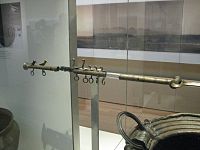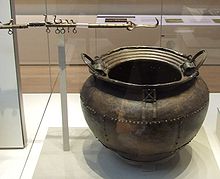- Dunaverney flesh-hook
-
Dunaverney flesh-hook 
Dunaverney flesh-hookMaterial Bronze Created late Bronze-age
(1050 BC – 900 BC)[1]Discovered 1829, Garry Bog, Dunaverney, Co. Antrim Present location British Museum Bronze Age
↑ Chalcolithic Near East (3300-1200 BC)
- Caucasus, Anatolia, Levant, Egypt, Mesopotamia, Elam, Jiroft
- Bronze Age collapse
Europe (3200-600 BC)
- Aegean (Minoan)
- Caucasus
- Catacomb culture
- Srubna culture
- Beaker culture
- Unetice culture
- Tumulus culture
- Urnfield culture
- Hallstatt culture
- Atlantic Bronze Age
- Bronze Age Britain
- Nordic Bronze Age
- Italian Bronze Age
Indian Subcontinent (3300-1200 BC)
China (3000-700 BC)
Korea (800-300 BC)
arsenical bronze
writing, literature
sword, chariot↓ Iron Age The Dunaverney flesh-hook is a sophisticated bronze artefact, of the type called flesh-hook, thought to be an item of ceremonial feasting gear. It dates from between 1050 and 900 BC, firmly within the Late Bronze Age. At the top of the artefact are a family of five birds, two larger birds followed by three smaller ones. At the bottom of the shaft, facing the family of five, are two birds. The two sets of birds could not be more different from one another. The group of two birds, presumably an adult pair, can be identified as corvids, perhaps ravens, the family of five as swans and cygnets. Instantly they invoke opposites: birds of water versus birds of the air; white ranged against black, fecundity as opposed to death implied by predatory character, birds of home territory versus those of wild places. It is easy with modern eyes to equate these qualities overall with the forces of good and evil.
Discovery
The Dunaverney flesh-hook was discovered in 1829 by people who were cutting turf at Dunaverney Bog to the north of Ballymoney, Co. Antrim, Northern Ireland. Antiquarians at that time knew of no parallel and struggled for the rest of the nineteenth century to understand its age and function. However, over time more examples were found, not only in Ireland and Britain, but also along the Atlantic seaboard of the European continent and it became clear from their style, technology and contexts that they belonged to the Bronze Age. To this day the representation of birds seen on the Dunaverney flesh-hook remains unique in north-west Europe.[2]
The Dunaverney flesh-hook is a unique symbol of authority from the Bronze Age. It is held by the British Museum.
References
- ^ "Bronze flesh-hook". The British Museum. 2010. http://www.britishmuseum.org/explore/highlights/highlight_objects/pe_prb/b/bronze_flesh-hook.aspx. Retrieved 29 June 2010.
- ^ "The Dunaverney and Little Thetford flesh-hooks: history, technology and their position within the later Bronze Age Atlantic zone feasting complex". Inist-Cnrs. http://cat.inist.fr?aModele=afficheN&cpsidt=19981831.
External links
- "Image of Dunaverney Flesh-hook". British Museum. http://www.britishmuseum.org/explore/highlights/highlight_image.aspx?image=ps259818.jpg&retpage=21035.
This article is about an item held in the British Museum. Object reference: 1856,1222.1.Categories:- Ancient Ireland
- Bronze Age Britain
- Prehistoric objects in the British Museum
- Archaeological artefacts
- Bronze Age art
Wikimedia Foundation. 2010.

